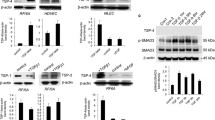Abstract
Several inhibitors of angiogenesis have been identified in bovine and shark cartilage. One of them is troponin I, which is the molecule responsible for the inhibition of the actomyosin ATPase during muscle contraction. In this study we sought to investigate if the active site of troponin I (peptide Glu94-Leu123; pTnI) is also the one responsible for the antiangiogenic properties of this protein. The effects of pTnI on endothelial cell tube formation and endothelial cell division were investigated using human umbilical vein endothelial cells, Matrigel, light microscopy, carboxyfluorescein diacetate, succinimidyl esterlabeling, and flow cytometry. Its effects on induction of ICAM-1 and production of vascular endothelial growth factor by pancreatic cancer cells (CAPAN-1) were also investigated, as was its efficacy in a mouse model of pancreatic cancer metastases. Our results show that concentrations as low as 1 pg/ml of pTnI significantly inhibit endothelial cell tube formation, and that endothelial cell division was inhibited at 96 hours by 3 μg/ml pTnI (P = 0.0001). No effects were seen using troponin peptide 124-181 as a control. pTnI-treated supernatant from the pancreatic cancer cell line CAPAN-1 downregulated ICAM-1 expression on human umbilical vein endothelial cells up to 10 ng/ml pTnI, and a significant reduction in vascular endothelial growth factor production was seen by treating CAPAN-1 cells with up to 1 μg/ ml pTnI. After intrasplenic injection of CAPAN-1 cells, mice treated with pTnI had fewer liver metastases compared to control mice (liver/body weight 5.5 vs. 11.1; P = 0.03). The active region of troponin I is the one responsible for its antiangiogenic effect. The mechanism of action of this peptide is probably multifactorial.
Similar content being viewed by others
References
FolkmanJ. What is the evidence that tumors are angiogenesis dependent? J Natl Cancer Inst 1990; 82:4–6.
Zetter BR. Angiogenesis and tumor metastasis. Annu Rev Med 1998;49:407–424.
Ellis LM, Liu W, Ahmad SA, Fan F, Jung YD, Shaheen RM, Reinmuth N. Overview of angiogenesis: Biologic implications for antiangiogenetic therapy. Semin Oncol 2001;28:94–104.
Kerbel RS. Tumor angiogenesis: Past, present and the near future. Carcinogenesis 2000;21:505–515.
Sheu JR, Fu CC, Tsai ML, Chung WJ. Effect of U-995, a potent shark cartilage-derived angiogenesis inhibitor, on antiangiogenesis and anti-tumor activities. Anticancer Res 1998; 18:4435–4441.
Oikawa T, Ashino-Fuse H, Shimamura M, Koide U, Iwaguchi T. A novel angiogenic inhibitor derived from Japanese shark cartilage (I). Extraction and estimation of inhibitory activities toward tumor and embryonic angiogenesis. Cancer Lett 1990;51:181–186.
Dupont E, Alaoui-Jamali M, Wang T. Angiostatic and antitumoral activity of AE-941 (Neovastat-R), a molecular fraction derived from shark cartilage. Proc Am Assoc Cancer Res 1997;38:A1530.
Moses MA, Wiederschein D, Wu I, Fernandez CA, Ghazizadeh V, Lane WS, Flynn E. Troponin I is present in human cartilage and inhibits angiogenesis. Proc Natl Acad Sci 1999;16:2645–2650.
Leavis P, Gergely J. Thin filament proteins and thin filamentlinked regulation of vertrebrate muscle contraction. CRC Crit Rev Biochem 1984;235–305.
Bhavsar PK, Brand NJ, Yacoub MH, Barton PJ. Isolation and characterization of the human cardiac troponin I gene (TNNI3). Genomics 1996;35:11–23.
Syska H, Wilkinson JM, Grand RJ, Perry SV. The relationship between biological activity and primary structure of troponin I from white skeletal muscle of the rabbit. Biochem J 1976;53:375–387.
Feldman L, Rouleau C. Troponin I inhibits capillary endothelial cell proliferation by interaction with the cell’s bFGF receptor. Microvasc Res 2002;63:41–49.
Magill C, Gosink L, Biroc S, Tam B, Qian F, Waldeck N, Shrader B, Spencer J, Martelli A, Mackman R. Effects of serine protease inhibitors in models of angiogenesis. Poster presented at the American Association for Cancer Research (AACR) meeting, New Orleans, LA, March 24–28, 2001.
Jimenez RE, Hartwig W, Antoniu BA, Compton CC, Warshaw AL, Fernandez-del Castillo C. Effect of matrix metalloproteinase inhibition on pancreatic cancer invasion and metastasis: An additive strategy for cancer control. Ann Surg 2000; 231:644–654.
Prudden JF. The treatment of human cancer with agents prepared from bovine cartilage. J Biol Response Mod 1998; 4:551–584.
Murray JB, Allison K, Sudhalter J, Langer R. Purification and partial amino acid sequence of a bovine cartilage-derived collagenase inhibitor. J Biol Chem 1986;261:4154–4159.
Moses MA, Sudhalter J, Langer R. Identification of an inhibitor of neovascularization from cartilage. Science 1990;248:1408–1410.
Takigawa M, Shirai E, Enomoto M, Hiraki Y, Fukuya M, Suzuki F, Shiio T, Yugari Y. Cartilage-derived anti-tumor factor (CATF) inhibits the proliferation of endothelial cells in culture. Cell Biol Int Rep 1985;9:619–625.
Folkman J. Seminars in Medicine of the Beth Israel Hospital, Boston. Clinical applications of research on angiogenesis. N EnglJMed 1995;333:1757–1763.
Itakura J, Ishiwata T, Shen B, Kornmann M, Korc M. Concomitant overexpression of vascular endothelial growth factor and its receptors in pancreatic cancer. Int J Cancer 2000; 85:27–34.
Itakura J, Ishiwata T, Friess H, Fujii H, Matsumoto Y, BuchlerMW, Korc M. Enhanced expression of vascular endothelial growth factor in human pancreatic cancer correlates with local disease progression. Clin Cancer Res 1997;3:1309–1316.
Kim I, Moon SO, Kim SH, Kim HJ, Koh YS, Koh GY. Vascular endothelial growth factor expression of intercellular adhesion molecule 1 (ICAM-1), vascular cell adhesion molecule 1 (VCAM-1), and E-selectin through nuclear factorkappa B activation in endothelial cells. J Biol Chem 2001; 276:7614–7620.
Author information
Authors and Affiliations
Additional information
Dr. Kern is supported by the Roche Research Foundation, Basel, Switzerland; the Novartis Stiftung, Basel, Switzerland; and the St. Clarastiftung, Basel, Switzerland.
Rights and permissions
About this article
Cite this article
Kern, B.E., Balcom, J.H., Antoniu, B.A. et al. Troponin i peptide (Glu94-Leu123), a cartilage-derived angiogenesis inhibitor: In vitro and in vivo effects on human endothelial cells and on pancreatic cancer. J Gastrointest Surg 7, 961–969 (2003). https://doi.org/10.1016/j.gassur.2003.08.003
Issue Date:
DOI: https://doi.org/10.1016/j.gassur.2003.08.003




